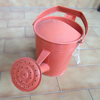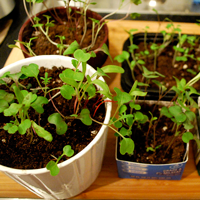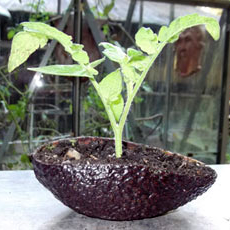
Guide for Making Indoor Gardens with Young Gardeners
JUST IN TIME FOR TU B'SHEVAT!
3rd Edition - 2017
14 Fantastic Planting Activities
Easy to Follow Instructions
Other Entertaining Facts About Plants
By:
DR. GABE GOLDMANPittsburgh Jewish Early Childhood Education &
Bonim Beyachad – Building Together, Consultant for
the Jewish Federation of Greater Pittsburgh and
Founder of Outdoor Jewish Classroom
A Message from Dr. Goldman
Winter is a funny time to celebrate Tu B’Shevat, the Jewish Arbor Day. Bare branches still silhouette the sky and the earth seems to shiver instead of blossom.
In Israel, of course, the rainy season has passed and the first buds begin to appear around Tu B’Shevat, the 15th of the Hebrew month of Shevat, which falls on February 11th this year. In the United States, much more is left to our imagination.
 Many people enjoy eating these
Many people enjoy eating these
7 symbolic fruits of Israel.
Learn more...
RESOURCES AND STARTING INSTRUCTIONS
SEEDS
 SOIL
SOIL

PLANTING CONTAINERS
 LIGHT CONDITIONS
LIGHT CONDITIONS
 WATERING
WATERING
 INDOOR GARDEN TOOLS
INDOOR GARDEN TOOLS
 OTHER RESOURCES
OTHER RESOURCES
NOTE: All of the activities require you to have resources ready for class. Some activities require starting seeds or plants weeks before you need to use them. Please read activities well in advance so that you will have what you need when you need it.
ABCs of PLANTING SEEDS AND TRANSPLANTING SEEDLINGS (Little Plants)
 Planting Seeds
Planting Seeds
 Transplanting Seedlings (Little Plants)
Transplanting Seedlings (Little Plants)

Creative Planting Pots
BENEFITS OF INDOOR GARDENING (FOR EARLY CHILDHOOD EDUCATORS)
1. Understand the World
Young children have one primary goal in their young lives – to understand the world around them. For better or worse, much of this understanding comes in the form of restrictions -- learning what not to do so as to avoid injury, learning how not to be inconsiderate of others, and so forth. Indoor gardening provides a new type of worldly understanding that is “expansive” rather than constrictive. Indoor gardening has the potential to be an empowering experience. For this to happen, it is necessary for children to take as active and participatory a role as possible in developing and maintaining their gardens.
2. Develop Self-esteem
Young children are developing the identities they will carry with them throughout their lives. Some researchers claim that a person's entire personality develops by the time they are five-years-old. Whether this is accurate or not, it is clear that children deserve to develop identities that are based on self-pride and self-esteem. Indoor gardening enables children to develop these qualities without being in competition with other children. And indoor gardens provide an on-going experience of pride mixed with awe and wonder. Children will see the continuing growth of their plants and experience pride in watering and caring for them.
3. Develop Social and Group Skills
Balancing the need for developing self-esteem is the need for young children to feel good about working and playing with other children. These feelings are the pre-requisites for their future development of interpersonal communication and group interaction skills. Indoor gardening provides children the opportunity to have a personal role while understanding and feeling good about having a “class” garden. Your motto might be, “It takes a class to grow an indoor garden.”
4. Enjoy Education
Fun and curiosity are the two primary motivators of young children’s learning. Early childhood educators understand that young children learn better when they are having fun and enjoying their learning. Indoor gardens are fun and they play to children’s natural curiosity.
5. Appreciate and Love Nature
Indoor gardening, especially when supplemented with some nature walks on school grounds, leads children to develop far greater appreciation and love for the natural world. These feelings are pre-requisites to the later development of Jewish identity that embraces the Torah’s view of people as “stewards of the earth,” the care-takers who can use any and all of the earth’s resources so long as they protect these resources for future generations to use.
6. Learn Gardening and Growing Skills
Last but not least, indoor gardening will teach children the same basic knowledge and skills used to grow healthy houseplants or huge outdoor gardens.
GARDENING AND NATURE PLAY
EVERYTHING WE LOOK FOR IN EARLY CHILDHOOD EDUCATION
✓ Learner-centered ~ intrinsically motivating and rewarding
✓ Hands-on ~ promotes sensory exploration
✓ Inclusive ~ connects children of all cultures, all ages, and all skill levels
✓ Socially bonding ~ provides interesting things to talk about and work on together
✓ Emotionally uplifting ~ builds self-efficacy and self-esteem
✓ Physically stimulating ~ promotes fine and gross motor skills
✓ Integrative ~ allows for seamlessly incorporating science, math, reading, social studies, and the arts
✓ Aesthetically appealing ~ offers opportunities to create and appreciate beauty
14 FANTASTIC PLANING ACTIVITIES
INTERESTING FACTS ABOUT PLANTS
❁ All parts of the tomato and potato plant, except for the potato bulb and the tomato fruit, are poisonous – this includes the leaves, flowers and stems.
❁ Day lilies grow yellow and orange flowers that are edible. One of its flower has at least as much Vitamin C as does an entire orange – without the acid. And each flower remains only for a day.
❁ Some plants open their flowers at night. This is because they are pollinated by moths which do not fly in the day.
❁ Certain kinds of pine trees must have their cones exposed to brushfire before their seeds will be able to germinate (like yucca). It is thought that horseradish became popular as a condiment because it does not need refrigeration.
❁ “An apple a day keeps the doctor away,” was first used to advertise the horticulture exhibit at the 1904 World’s Fair in St. Louis, MO.
❁ The sweet orange is now thought to be the single most commonly grown fruit tree in the world.
❁ Agave is a cactus-like plant that is nicknamed the “Century Plant.” This is because agave produces flowers only one time in its life and it takes between 75-100 years to happen.
❁ Jewel weed is a plant that grows in the eastern United States. When submerged in water, its leaves take on the appearance of silver – ergo its name.
❁ One carob tree can easily produce over 1,000 pounds of carob pods.
❁ Cactus plants breathe twice a day. In the early morning they breathe in. After dark they breathe out. This helps lessen the amount of water that evaporates when their pores are open.
Back to top